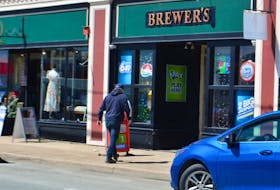Nicole Whiteway developed a routine since the start of the pandemic.
She wears a mask, maintains physical distancing, washes her hands often, and showers every day after coming back from work.
But as a teacher at a large high school, she spends long hours with about 1,500 other people.
“That’s a whole lot of bubbles in one place,” she said in an interview Wednesday.
Whiteway also lives with her mother, who is in her 70s, so she always feels nervous about bringing COVID-19 home.
When Nova Scotia set up its first pop-up clinic for asymptomatic testing in late November, Whiteway saw it as an opportunity to add one more layer to her COVID-prevention routine.

Then in early December, the province announced that people could book an appointment online to get a free asymptomatic test done. Whiteway, who lives in the Halifax Regional Municipality, decided to get a test every other Saturday.
“It’s unbelievably easy,” she said. “I usually book it on my way there. … There’s enough testing capacity in the city to find somewhere when I’m available and I’m in and out in five minutes.”
Less people getting tested
While thousands of people got asymptomatic tests when they were first introduced, Whiteway now appears to be in the minority.
In a live briefing Wednesday, Dr. Robert Strang, the province's chief medical officer of health, said the number of people getting asymptomatic tests through pop-up sites or appointments has decreased.
Pop-up clinics use rapid tests, where people can get their result in as little as 30 minutes. Appointment-based asymptomatic tests use a sensitive method, called polymerase chain reaction (PCR), to identify traces of the virus and the result is ready within 72 hours in most cases. In both tests, the nose swab is used to collect the sample for adults.
“It seems like people feel as we have very low case numbers, we don’t need to be so worried,” he said. “That couldn’t be further from the truth.”

Dr. Lisa Barrett, infectious diseases doctor and scientist at Dalhousie University, said 30 per cent of people who have COVID-19 don’t know they have it.
“So, I want people to know that just because you don't have symptoms and we are diagnosing zero cases, doesn't necessarily mean that there are zero cases in the province.”
During the second wave of the pandemic, 14 per cent of cases in Nova Scotia have been asymptomatic, said Marla McInnis, a spokesperson with the Department of Health and Wellness.
That means out of 495 positive cases reported to date, 69 people who tested positive for COVID-19 did not have symptoms.
Asymptomatic testing is one way for Public Health to find these cases before they spread the virus into the community.
“It's kind of like an earthquake monitor … Just because you haven't had an earthquake in a little while, you keep the earthquake monitor on, particularly between earthquakes, so you know that one is coming,” said Barrett.
Do asymptomatic tests give false results?
When doing asymptomatic testing in communities where there are very low case numbers, there’s a chance of getting a greater number of false positive or false negative results.
A false positive is when a test result shows a person has a virus or disease when they don’t. A false negative test result could happen early in infection, said Barrett, where a person would have “a little bit of virus hanging around but not enough to make the test positive.”
Barrett said there’s no perfect method that could identify all COVID-19 infections, but that’s not the purpose of asymptomatic tests.
“Our questions are a little bit different. It's can we find some people who would otherwise not be tested at all because they don't have symptoms or risks? Can we find those folks early and use one of two tests to identify them?”
"Even if we find one true positive, we've possibly prevented 10 new infections.”
Confirming a positive result
A positive test determined through PCR is considered a true positive and doesn’t need additional confirmation, said Barrett. But if someone gets a positive result through a rapid test, they’re asked to get tested again at a primary assessment centre where PCR is used.
Barrett said there have been about 25 people who got tested at a rapid testing pop-up clinic and received a false positive result. The pop-up sites identified 12 to 14 true positive cases and 16,000 negatives.

While a positive test result determined through PCR is a true positive, it doesn’t always mean a person has an active infection.
“They could be way, way beyond the active infection and they just are what we call shedding some virus that's not particularly infectious.”
PCR is so sensitive that it can pick up on dead virus fragments. On the other hand, the less sensitive rapid test can only pick up on live infectious virus. So, if a positive case from a rapid test is confirmed through PCR to be a true positive, it means a person has an active infection and could spread the disease.
You don't need to self-isolate
Some of the misconceptions Barrett hears a lot about asymptomatic testing are related to self-isolation.
She said that a person doesn’t have to self-isolate if they go to a testing site at the same time as another person who later tests positive. If someone gets a positive result through a rapid test and it’s later determined to be a false positive through PCR, they also don’t have to stay off work or self-isolate.
Barrett added that she hoped more people would add asymptomatic testing to their routine and those who already get tested would do it more often.
“We have one of the strongest programs of no-symptoms testing in the country,” she said. “It's really important that we don't think that with zero cases, we don't need to continue it. It's in fact, way more important, especially with variants coming our way that can be more transmittable.”








